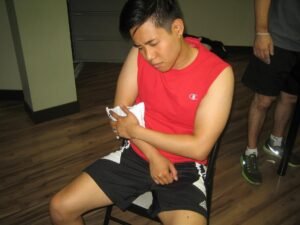Even though throwers elbow is not as common as tennis elbow, it can be debilitating and painful. This condition is quite common among baseball pitchers but can also occur in any sport that requires a throwing motion, including javelin, cricket, volleyball and tennis. Throwers elbow can affect both the interior and exterior of the elbow.
What are the causes?
The usual cause of throwers elbow is overuse. Any action that will add constant and extended strain on the forearm muscles along with inadequate rest will overwork the muscles.
There are also other causes such as a fall, direct trauma or a bump on the elbow. In addition, poor technique will also contribute to the condition such as using ill-fitting equipment such as tennis racquets, golf clubs and even work tools. Even a poor level of fitness and conditioning can also contribute.

What are the signs and symptoms?
Pain is the most common and distinctive symptom linked with throwers elbow. The pain is typically experienced on both sides of the elbow joint but can also occur on any point from the elbow joint up to the wrist.
Stiffness, weakness and generalized limitation of movement are also common among those who suffer from throwers elbow. Even numbness and tingling can occur as well.
Prevention
There are a number of preventive measures that will help prevent the development of throwers elbow including strapping, bracing, modifying equipment, getting enough rest and learning new routines for repetitive activities. Nevertheless, there are preventive measures that are vital and effective.
- Proper warm up will prepare the muscles and tendons for activity. Lack of warm up will cause tightness and stiffness of the muscles and tendons. With this in mind, warm up must be performed before any activity.
- Muscles and tendons that are flexible are vital in preventing strain or sprain injuries. If muscles and tendons are supple, they can move and perform without being overly stretched.
- Conditioning and strengthening of the muscles of the forearm and wrist will prevent throwers elbow. There are specific strengthening exercises for the muscles.
Treatment of throwers elbow
Throwers elbow is a soft tissue injury involving the muscles and tendons around the elbow joint and must be treated as a soft tissue injury. Right after the injury or start of the pain, you have to utilize the RICE method (rest, ice, compression, elevation).
Always remember that the RICE method must be started at least the first 48-72 hours. This will ensure the best chance for full recovery. The next phase of the treatment involves physiotherapy techniques. Reducing the risk of scar tissue and speeding up the recovery of the muscles and tendons can be achieved with the application of heat and massage.
Once the pain subsides, the individual should start the rehabilitation program. The objective of this program is to restore the power, strength, flexibility and endurance of the muscles and tendons that have been damaged.
